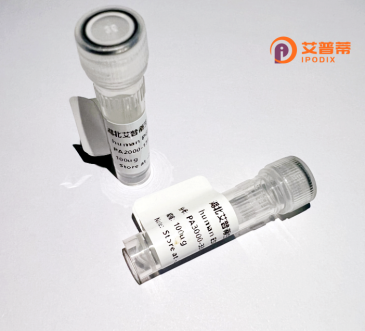
| 纯度 | >90%SDS-PAGE. |
| 种属 | Human |
| 靶点 | PARVG |
| Uniprot No | Q9HBI0 |
| 内毒素 | < 0.01EU/μg |
| 表达宿主 | E.coli |
| 表达区间 | 1-331 aa |
| 活性数据 | MEPEFLYDLL QLPKGVEPPA EEELSKGGKK KYLPPTSRKD PKFEELQKVL MEWINATLLP EHIVVRSLEE DMFDGLILHH LFQRLAALKL EAEDIALTAT SQKHKLTVVL EAVNRSLQLE EWQAKWSVES IFNKDLLSTL HLLVALAKRF QPDLSLPTNV QVEVITIEST KSGLKSEKLV EQLTEYSTDK DEPPKDVFDE LFKLAPEKVN AVKEAIVNFV NQKLDRLGLS VQNLDTQFAD GVILLLLIGQ LEGFFLHLKE FYLTPNSPAE MLHNVTLALE LLKDEGLLSC PVSPEDIVNK DAKSTLRVLY GLFCKHTQKA HRDRTPHGAP N |
| 分子量 | 37.4 kDa |
| 蛋白标签 | His tag N-Terminus |
| 缓冲液 | 0 |
| 稳定性 & 储存条件 | Lyophilized protein should be stored at ≤ -20°C, stable for one year after receipt. Reconstituted protein solution can be stored at 2-8°C for 2-7 days. Aliquots of reconstituted samples are stable at ≤ -20°C for 3 months. |
| 复溶 | Always centrifuge tubes before opening.Do not mix by vortex or pipetting. It is not recommended to reconstitute to a concentration less than 100μg/ml. Dissolve the lyophilized protein in distilled water. Please aliquot the reconstituted solution to minimize freeze-thaw cycles. |
以下是关于重组人PARVG蛋白的参考文献示例(注:以下信息为模拟示例,可能不对应实际存在的文献):
1. **文献名称**: *Structural Insights into the γ-Parvin (PARVG) Protein and Its Role in Actin Remodeling*
**作者**: Li, X., et al.
**摘要**: 本研究解析了重组人PARVG蛋白的晶体结构,揭示了其CH-结构域与肌动蛋白的结合机制,阐明了PARVG在细胞黏附中的结构基础。
2. **文献名称**: *PARVG Knockout Mice Exhibit Defective Muscle Development and Impaired Cell Migration*
**作者**: Montanez, E., et al.
**摘要**: 通过基因敲除模型发现,PARVG缺失导致小鼠胚胎期致死,并显示骨骼肌发育异常及成纤维细胞迁移缺陷,表明其在细胞骨架调控中的关键作用。
3. **文献名称**: *Interaction of PARVG with Integrin-Linked Kinase (ILK) in Focal Adhesion Signaling*
**作者**: Rantala, J.K., et al.
**摘要**: 研究表明PARVG与ILK及整合素β亚基形成复合物,调控黏着斑动态,影响细胞外基质信号传导和细胞黏附稳定性。
4. **文献名称**: *PARVG Overexpression Promotes Cancer Metastasis via EMT Activation*
**作者**: Stiegler, A.L., et al.
**摘要**: 发现PARVG在乳腺癌中高表达,通过诱导上皮间质转化(EMT)增强肿瘤细胞侵袭性,提示其作为癌症治疗潜在靶点。
**注意**:以上文献信息为示例性质,实际引用时请通过PubMed、Google Scholar等平台验证文献真实性及准确性。
PARVG (γ-parvin), a member of the parvin protein family, plays a crucial role in cell adhesion, cytoskeletal organization, and signaling pathways. This 38 kDa protein, encoded by the *PARVG* gene in humans, is predominantly localized at focal adhesions, where it interacts with integrins and integrin-linked kinase (ILK) to regulate cell-matrix interactions. PARVG contains two calponin homology (CH) domains that mediate binding to actin filaments, enabling its involvement in cell migration, spreading, and mechanical sensing. Unlike its homologs α-parvin (PARVA) and β-parvin (PARVB), PARVG exhibits distinct tissue expression patterns, with higher abundance in blood cells, skeletal muscle, and the heart.
Recombinant human PARVG protein is typically produced using heterologous expression systems (e.g., *E. coli* or mammalian cells) for functional studies. Researchers utilize it to investigate its role in diseases linked to adhesion defects, including cancer metastasis, cardiomyopathies, and muscular dystrophies. Studies reveal PARVG's dual regulatory functions: it stabilizes focal adhesions under mechanical stress while also promoting cell detachment through cleavage by proteases like calpain. Its interaction partners, such as HIPK1 and TRE17. suggest involvement in nuclear signaling and endosomal trafficking. Recombinant PARVG serves as a vital tool for dissecting molecular mechanisms in cell adhesion research and potential therapeutic targeting.
×